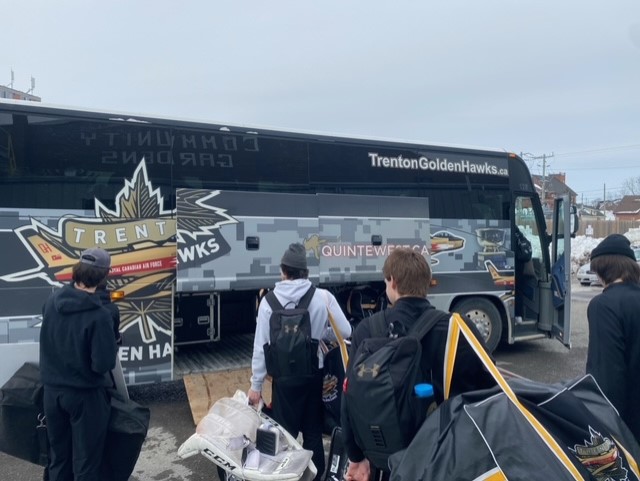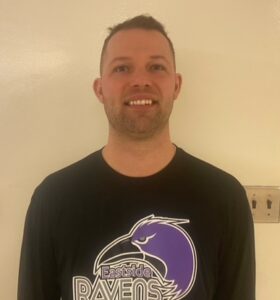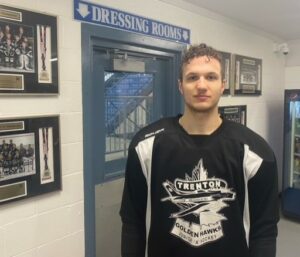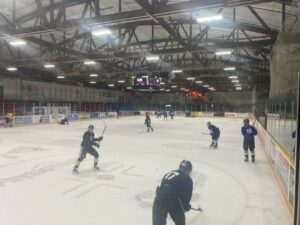
Travelling around the province is part of life for junior hockey players. Here, members of the Trenton Golden Hawks board the bus for a game in Oakville. The time commitment for travel and games mean they have fit in their academic work when and where they can. Photo by Jordan Mills, QNet News
By Jordan Mills
BELLEVILLE – Hockey’s more than a sport in Canada; it’s a part of the culture. Children grow up on frozen ponds dreaming of one day playing in the National Hockey League. Hardly any of them will get to that level – but that doesn’t stop many young athletes playing for as long as they can, at the highest level they are capable of. But in the meantime, they have their classes at school to worry about and homework to finish on the bus.
So what happens with their education when they start to age out or are unable to play at a professional level?
Players between the ages of 16 and 21 who make high-level teams like the Trenton Golden Hawks and Wellington Dukes of the Ontario Junior Hockey League – teams that for the talented few can be a stepping stone to a pro career – have their high-school or postsecondary education to consider even while they’re out there on the ice. Until a few years ago, education for these athletes was often an afterthought, with the result that many were left with little or no education and thus reduced job opportunities once their hockey careers were over.
In recent years, however, making sure these young people – many of whom are living away from home in order to be able to play – have the resources and tools to keep their grades up has become more of a priority for junior-hockey teams.
Some teams take the players’ education very seriously. Players have been left off the roster due to poor school-attendance issues, failing to hand in assignments, or just overall poor grades.
One local high school that’s had experience with junior hockey players as students is Eastside Secondary in Belleville. Physical-education teacher Cole Lynch has had several players in his classes and knows the ins and outs of the programs provided to the athletes.

Eastside Secondary School phys-ed teacher Cole Lynch has worked closely with junior hockey players trying to complete their high-school education. He understands the pressure many of them face to perform on the ice and at school, he says. Photo by Jordan Mills, QNet News
If players need additional help, they can reach out to the school’s support services through an educational liaison who’s with their team, Lynch explained in an interview with QNet News. The guidance department and the school’s student success department will come up with a plan to help the athlete.
“The ultimate goal for these students is to obtain an Ontario Secondary School Diploma,” said Lynch. School staff “look at things as simple as their schedule and when they are available. Do they practise in the morning, or do they practise after school? … Every student is unique when it comes to their schedule.”
Before players start at Eastside, the staff get a package on them from the team. A lot of the information comes from their previous schools – whether another high school or an elementary school.
Because of their talent, these players have a lot of opportunities from a young age, and it’s easy for them to downplay the importance of education, Lynch said. An academic backup plan is something every junior player should have, he said.
While some players will always put more energy into their studies than others, there is more of an effort than there used to be to make sure they are set up for success after hockey, Lynch said. The days of players doing most of their schoolwork while riding the team bus are drifting away, he said, adding that the rise of online and remote learning has been a boon.

Sami Douglas-Najem, a defenceman for the Trenton Golden Hawks, says that no matter what happens with his hockey career, he’ll make sure he gets a university education. Photo by Jordan Mills, QNet News
Sami Douglas-Najem, 19, of Belleville, who plays defence for the Golden Hawks, is coming to the end of his junior hockey career and facing decisions about his hockey, education and career future. A graduate of Eastside Secondary, he’s taking a gap year in his education to focus on hockey, but has applied to Waterloo, Queen’s and the University of Toronto for the 2023-24 school year, when he hopes to study part-time doing online courses.
“I think for anyone playing junior hockey, they’d like to play hockey as long as they can and go as far as they can, whether it’s the (American Hockey League), or Europe, or something,” Douglas-Najem told QNet News in an interview at Trenton’s Duncan McDonald arena after a recent team practice. “But if that doesn’t work out, I’m a big school guy. I’m hopeful I can go to one of those universities … and just start my education.”
To him, education is as important as hockey, if not more so, he said.
“I consider myself a student athlete and that school should always come first and hockey second. As long as you’re keeping a good balance, that’s a good mindset for everybody.”
After signing with the Ontario Hockey League’s Niagara IceDogs in September 2021, Douglas-Najem played 20 games. Based on the contract that he signed, the moment he stepped on the ice for the Ice Dogs he got his first two years of university paid for, even though he subsequently was sent back to play with the lower-level Golden Hawks. But the contract only helps if the player is going to Canadian universities. So those planning on going to a university that’s a part of the National Collegiate Athletic Association in the United States wouldn’t get any financial aid from the OHL.

The Trenton Golden Hawks finish a practice at the Duncan McDonald arena in late February in preparation for the playoffs. The schedule of a junior hockey player is packed with practices, games, meetings and travel. Photo by Jordan Mills, QNet News
Keeping junior players in Canada so they can attend Canadian universities has become more of a challenge recently. With the NCAA offering more scholarship opportunities and a higher level of play, more and more junior players are choosing that route. The NCAA also prohibits anyone who played any games in the Ontario Hockey League, or the other two leagues that make up the Canadian Hockey League, from playing varsity hockey, which limits these players’ options even further. The NCAA views the CHL as a professional league based on the per-diem payment that the players get.
Jerome Dupont, head coach of the Golden Hawks and a onetime player with the NHL’s Chicago Blackhawks and Toronto Maple Leafs, says he’d like to see more of an incentive for players to attend Canadian universities.
There should be more scholarships to Canadian universities, Dupont said. “The calibre of (Canadian university) hockey is fantastic. It’s as good as D1 (the highest level of NCAA hockey) and better than D3 (the third tier in the NCAA). So it would be nice to see more scholarship money for those going to Canadian universities.”
The marketing of Canadian university hockey could also be improved, Dupont said. Citing his time as the head hockey coach at Brock University, he said the level of play is better than the league is given credit for.
On the education front, things have changed a lot since Dupont’s time playing junior hockey with the Toronto Marlboros in the early 1980s, he said. Players then were often given a pass on their poor grades and school attendance if their hockey skills were high. Outside resources for help with schooling were limited.
“There might’ve been four or five guys who were serious with their studies,” he said. “Everybody else thought they were going to play some version of pro hockey. In a lot of cases it didn’t materialize, and if it did it was short-lived. Today there is a much larger emphasis on getting an education, and it’s not just lip service.”
The Golden Hawks and schools in the Quinte region offer private tutors, online learning, part-time studies, one-on-one time with teachers, access to counsellors and therapists, and flexible deadlines.
Curtis Leonard has experienced both junior hockey, as a Wellington Dukes player from 2008 to 2011, and post-secondary education. After he left the Dukes, he attended Rensselaer Polytechnic Institute in Troy, N.Y., for four years. After graduation, he played professional hockey in the East Coast Hockey League and a year in Northern Ireland for the Belfast Giants of the Elite Ice Hockey League.
During his time with the Dukes, Leonard said, the academic assistance programs were not as robust as they are today. The major resources provided to him and his teammates were tutors and private lessons, he said.
“It’s definitely gotten easier to go to school now, compared to when I was playing. Online learning wasn’t really a thing back then, so the only option you had was to make it to every class. There were a lot of days where you didn’t get back home until 4 in the morning and then had class at 7.”
Leonard, now 30, is a partnership manager for Paper, an online learning tool to help students. “I didn’t really plan on that happening,” he said with a laugh. “But it’s cool to think I may be able to help out someone in junior (hockey) now.”
It was a cool experience to live out his childhood dream and be a pro hockey player, Leonard said. It wasn’t the NHL, but he was still getting paid to play hockey.
“It wasn’t all that glamorous … since we only got a few hundred (dollars) every two weeks. It worked out for me, but there are still guys grinding it out in the (ECHL) with nothing else to really fall back on. It’s always good to have a backup plan for when you have to call it quits.”
 Print This Post
Print This Post






